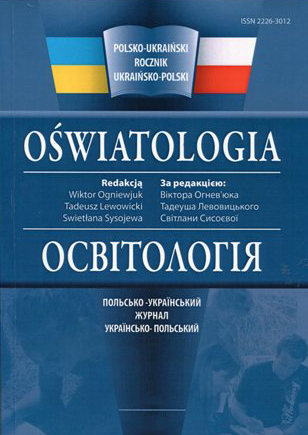TEACHER TOWARDS CHILD WITH ASPARGERʹS SYNDROME
DOI:
https://doi.org/10.28925/2226-3012.2018.7.9096Keywords:
Asperger's disorder, social behavior, stereotypes, fixation, sensory sensitivityAbstract
The article presents the characteristics of the specific features which occur in children with diagnosed Asperger's syndrome. Within each of these features guidance for teachers is provided to enable understanding of the needs of these children and to facilitate working with them in the classroom. Tips for teachers were developed based on the literature and personal author's years of experience while working with such students.
References
Attwood, T. (2006). Zespół Aspergera. Poznań, Rzeczpospolita Polska: Wydawnictwo Zysk i S-ka (pol).
Delacato, C. H. (1995). Dziwne niepokoje. Autystyczne dziecko. Warszawa, Rzeczpospolita Polska: Fundacja «Synapsis» (pol).
Gałkowski, T. (1995). Dziecko autystyczne w środowisku rodzinnym i szkolny. Warszawa, Rzeczpospolita Polska: WSiP (pol).
Gałkowski, T., & Kossewska, J. (red.) (2004). Autyzm wyzwaniem naszych czasów. Kraków, Rzeczpospolita Polska: Wydawnictwo Naukowe Akademii Pedagogicznej w Krakowie (pol).
Maciarz, A., & Banasiewicz, M. (2000). Dziecko autystyczne z zespołem Aspergera. Kraków, Rzeczpospolita Polska: Oficyna Wydawnicza «Impuls» (pol).
Pecyna, M. B. (1998). Psychologia Kliniczna w praktyce pedagogicznej. Warszawa, Rzeczpospolita Polska: Wydawnictwo «Żak» (pol).
Sillami, N. (1999). Słonik psychologii. Katowice, Rzeczpospolita Polska: Wydawnictwo «Książnica» (pol).
Winter, M. (2006). Zespół Aspergera, co nauczyciel wiedzieć powinien. Warszawa, Rzeczpospolita Polska: Wydawnictwo «Fraszka edukacyjna» (pol).
Published
How to Cite
Issue
Section
License
Copyright (c) 2018 Марія Хмєлевська

This work is licensed under a Creative Commons Attribution-NonCommercial 3.0 Unported License.
Content Licensing: Creative Commons Attribution Non-Commercial
The author allows:
- Share — copy and redistribute the material in any medium or format
- Adapt — remix, transform, and build upon the material
Under the following terms:
-
Attribution — You must give appropriate credit, provide a link to the license, and indicate if changes were made. You may do so in any reasonable manner, but not in any way that suggests the licensor endorses you or your use.
-
NonCommercial — You may not use the material for commercial purposes.
The authors reserve the right to authorship of the work and pass the first publication right of this work to the journal under the terms of a Creative Commons Attribution License, which allows others to freely distribute the published research with the obligatory reference to the authors of the original work and the first publication of the work in this journal.
The authors have the right to conclude separate supplement agreements that relate to non-exclusive work distribution in the form in which it has been published by the journal (for example, to upload the work to the online storage of the journal or publish it as part of a monograph), provided that the reference to the first publication of the work in this journal is included.





